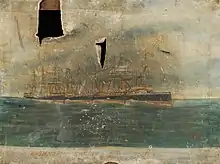HMS Swallow (1885)
HMS Swallow was a Nymphe-class composite screw sloop and the twenty-seventh ship of the Royal Navy to bear the name. Developed and constructed for the Royal Navy on a design by William Henry White, Director of Naval Construction, she was launched at Sheerness Dockyard on 27 October 1885.[5]
| History | |
|---|---|
| Name: | HMS Swallow |
| Builder: | Sheerness Dockyard |
| Cost: | £44,797 (hull), £15,000 (machinery)[1] |
| Laid down: | 1 November 1885[1] |
| Launched: | 27 October 1885[1] |
| Commissioned: | 7 October 1886[1] |
| Fate: | Sold 1904[2] |
| General characteristics [3] | |
| Displacement: | 1,140 long tons (1,160 t) |
| Length: | 195 ft (59.4 m) |
| Beam: | 28 ft (8.5 m) |
| Draught: | 12 ft 6 in (3.8 m) |
| Propulsion: |
|
| Sail plan: | Schooner-rigged |
| Speed: | 13.5 kn (25.0 km/h; 15.5 mph) |
| Endurance: | 3,000 nmi (5,600 km; 3,500 mi) at 10 kn (19 km/h; 12 mph) |
| Complement: | 138 |
| Armament: |
|

Service history
Swallow was engaged in East Africa in the expedition against Fumo Amari, who was the Sultan of Wituland (in modern day Kenya). The expedition resulted in the capture of Pumwani and Jongeni, between 7 and 13 August 1893. [6] The Ashantee Medal was awarded to those who were employed on her together with the clasp "Witu 1893". [7]
Swallow was commissioned by commander Edward Fitzmaurice Inglefield in 1899 to serve on the South America Station. She was in Montevideo in late February 1900, and visited the Falkland Islands the following month.[8]
Fate
Swallow was sold to McCausland & Sons in 1904.[1]
References
- Winfield (2004)
- "Naval Sloops at battleships-cruisers.co.uk". Retrieved 8 December 2017.
- Chesneau and Kolesnik 1979, pp. 58.
- Preston (2007) p.182
- Naval sloops
- The Kings African Rifles https://books.google.co.uk/books?id=Q3C-BAAAQBAJ&lpg=PA98&dq=pumwani%20jongeni%20august%201893&pg=PA98#v=onepage&q=pumwani%20jongeni%20august%201893&f=false
- THE LONDON GAZETTE, MARCH 20, 1906 https://www.thegazette.co.uk/London/issue/27896/page/1971/data.pdf
- "Naval & Military intelligence". The Times (36076). London. 27 February 1900. p. 6.
- Winfield, R.; Lyon, D. (2004). The Sail and Steam Navy List: All the Ships of the Royal Navy 1815–1889. London: Chatham Publishing. ISBN 978-1-86176-032-6.
- Preston, Antony; Major, John (2007). Send a Gunboat: The Victorian Navy and Supremacy at Sea, 1854–1904 (2nd ed.). London: Conway. ISBN 978-0-85177-923-2.